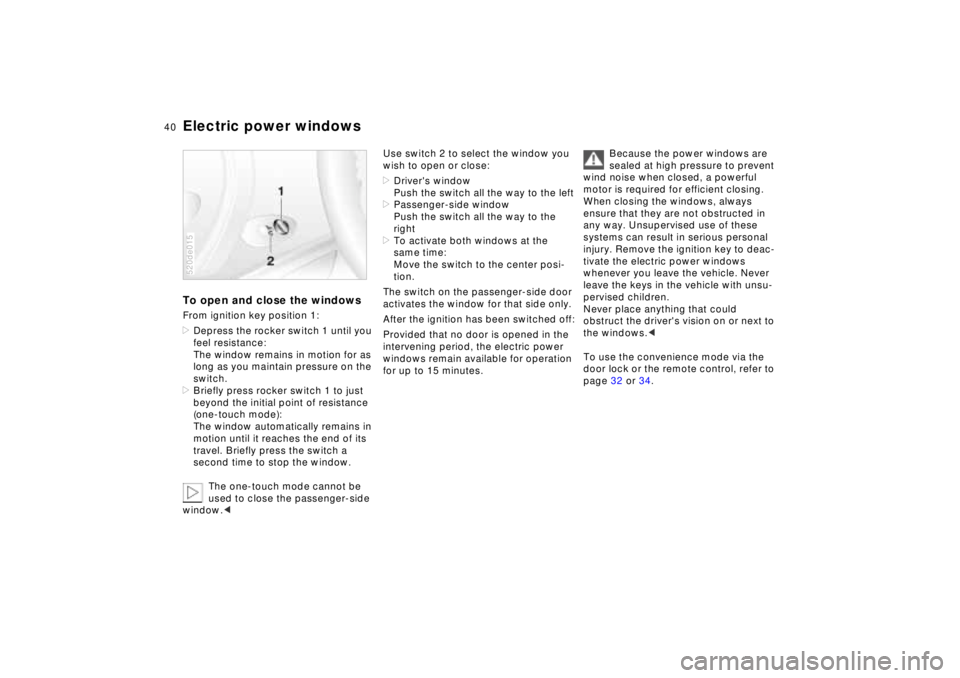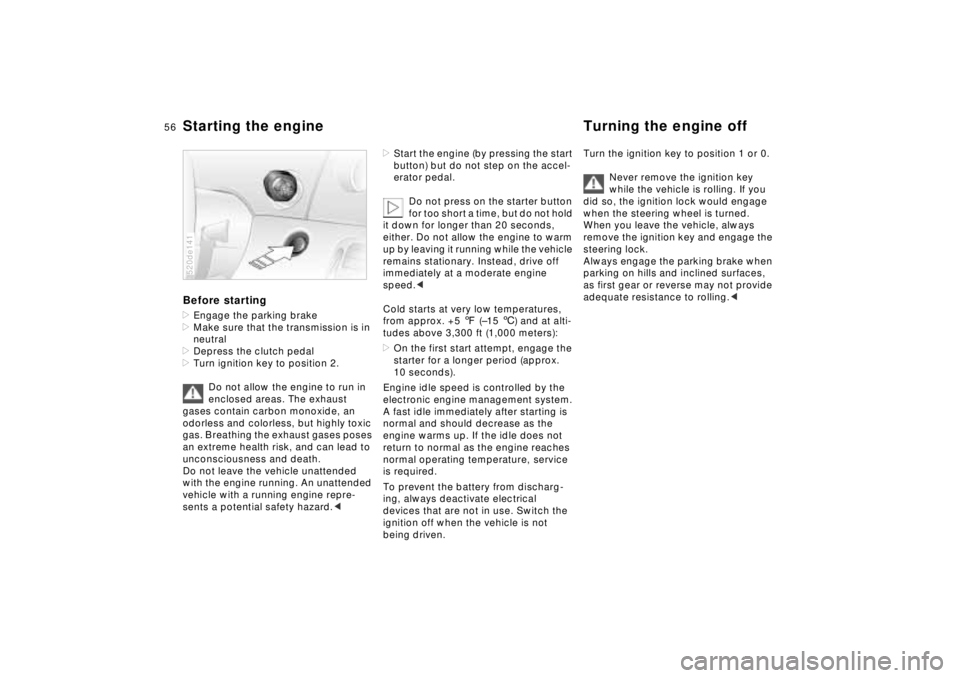2001 BMW Z8 ECO mode
[x] Cancel search: ECO modePage 3 of 170

Congratulations, and thank you for choosing a BMW.
Thorough familiarity with your vehicle will provide you with enhanced control and
security when you drive it. We therefore have this request:
Please take the time to read this Owner's Manual and familiarize yourself with the
information that we have compiled for you before starting off in your ne w BMW. It
contains important data and instructions intended to help you derive maximum use
and satisfaction from your BMW's unique range of technical features. The manual
also contains information on care and maintenance designed to enhance operating
safety and contribute to maintaining the value of your vehicle throughout an
extended service life.
This manual is supplemented by a Service and Warranty Information Booklet
(US models) or a Warranty and Service Guide Booklet (Canadian models).
We recommend that you read the applicable publication thoroughly.
Your BMW is covered by the following warranties:
Ð New Vehicle Limited Warranty
Ð Limited Warranty Rust Perforation
Ð Federal Emissions System Defect Warranty
Ð Federal Emissions Performance Warranty
Ð California Emissions Control System Limited Warranty
Detailed information concerning these warranties is provided in the Service and
Warranty Information Booklet (US models) or in the Warranty and Service Guide
Booklet (Canadian models).
We wish you an enjoyable driving experience.
BMW AG
Page 21 of 170

21n
IndexDataTechnologyRepairsCar careControlsOverview
Indicator and warning lamps
Red and yellow: continue driving
cautiously
The red brake warning lamp
comes on together with the
yellow indicator lamps for ABS
and DSC:
The entire ABS, CBC, DSC and
DBC control system has failed.
Continue driving cautiously and
defensively. Avoid hard brake
applications. Please have the
system checked by your BMW center
as soon as possible.
For additional information, refer to
pages 65, 88.
Indicator and warning lamps for
Canadian models.
Red: an important reminder
Brake warning lamp
l
Comes on when the parking
brake is applied Ð an additional
acoustic signal sounds when the
vehicle is set in motion.
For additional information, refer to
page 57.
Brake warning lamp for Cana-
dian models.
Please fasten safety belts
l
Together with an acoustic
signal. Comes on until the safety
belts are fastened.
For additional information on safety
belts, refer to page 50.
Airbags
l
Please have the system
inspected by your BMW center.
For additional information, refer to
pages 51, 148.
Yellow: check at the earliest
opportunity
Antilock Brake System (ABS)
l
ABS has been deactivated in
response to system malfunction.
Unrestricted conventional brake system
performance remains available. Please
have the system inspected by your
BMW center.
For additional information, refer to
page 88.
Antilock Brake System (ABS)
warning lamp for Canadian
models.
Engine oil level
Comes on while driving: the oil
level is at the absolute minimum;
add engine oil as soon as possible. Do
not drive more than approx. 30 miles
(50 km) without stopping to add oil.
For additional information, refer to
page 109.
Engine oil level
Comes on after the engine has
been shut off: add engine oil at
the earliest opportunity (when you stop
to refuel).
For additional information, refer to
page 109.
Page 33 of 170

33n
IndexDataTechnologyRepairsCar careControlsOverview
Opening and closing Ð from outsideUsing the remote control Remote control offers you optimal
convenience in using your vehicle's
locking system while also providing
three exclusive supplementary features:
>Interior lamp activation, refer to
page 34.
With this function, you can also
"search for" your vehicle Ñ if, for
example, it is parked in an under-
ground garage.
>Opening the luggage compartment
lid, refer to page 35.
>Panic mode, refer to page 35.
In case of danger, you can trigger
an alarm.
The anti-theft system is also deacti-
vated/activated simultaneously with the
unlocking or locking of the vehicle, and
the alarm system is disarmed/armed,
and the interior lamps are turned on/off.
Master keysKeys with remote control are master
keys. Refer to page 30.
You can have different confirma-
tion signals programmed into the
system to verify that the vehicle has
been locked correctly.<
Because children left within the
vehicle could lock the doors from
the inside, you should always remove
the key and take it with you to ensure
that you remain able to unlock the
vehicle from the outside at all times.<520de010
Master keys that are used repeat-
edly are always ready for opera-
tion since the battery in the key is
charged automatically in the steering
lock every time you drive.
If it is no longer possible to unlock the
vehicle via the remote control, the
battery is discharged. Use this key
while driving for an extended period in
order to charge the battery. Refer also
to page 30.
To prevent unauthorized use of the
remote control, surrender only the door
and ignition key 3 or the spare key 2
(refer to page 30) when leaving the
vehicle for valet parking, for example.
In the event of a system malfunction,
please contact your BMW center. You
can also obtain replacement keys
there.<
Page 34 of 170

34n
Opening and closing Ð from outsideTo unlock the vehiclePress button 1.
Press the button once to unlock the
driver's door only; press it a second
time to unlock the passenger door, the
luggage compartment lid, the fuel filler
door, the glove compartment, and the
cellular phone holder.
If necessary, you can open the fuel filler
door by pressing the button inside the
vehicle; refer to page 25.Convenience opening modePress and hold button 1. The windows
are then opened.520de143
To lock and secure Press button 2.
You can have different confirma-
tion signals programmed into the
system to verify that is has assumed
active operational status.<520de145
To deactivate the tilt sensor alarm
system and interior motion sensor Press button 2 again immediately after
locking.
For additional information, refer to
page 39.To switch on the interior lamps After locking the vehicle, press button 2
again.520de145
Page 35 of 170

35n
IndexDataTechnologyRepairsCar careControlsOverview
Opening and closing Ð from outsideTo open the luggage
compartment lid Press button 3.
The luggage compartment lid opens
slightly.
Before and after a trip, be sure
that the luggage compartment lid
has not been opened unintentionally.
more than two seconds to trigger the
alarm system by hand. The alarm
system must be armed in advance for
this function to operate.
To switch off the alarm, press button 1.520de144
Interference from outside
systemsThe remote control system's perform-
ance may be affected by other equip-
ment operating in the vehicle's vicinity.
You can respond to problems of this
nature by using the master key to
engage and release the locks at the
door.
For US owners onlyThe transmitter and receiver units
comply with Part 15 of the FCC (Federal
Communications Commission) regula-
tions. Operation is governed by the
following:
FCC ID: LX8EWS
LX8FZVS
LX8FZVE
Compliance statement:
This device complies with Part 15 of the
FCC Rules. Operation is subject to the
following two conditions:
>This device may not cause harmful
interference, and
>this device must accept any interfer-
ence received, including interference
that may cause undesired operation.
Any unauthorized modifications or
changes to these devices could
void the user's authority to operate this
equipment.<
Page 39 of 170

39n
IndexDataTechnologyRepairsCar careControlsOverview
Alarm system>The indicator lamp flashes for
10 seconds when the system is
disarmed: an attempted entry has
been detected in the period since the
system was armed.
Following triggering of an alarm, the
indicator lamp will flash continuously.Avoiding unintentional alarms The tilt alarm sensor and interior motion
sensor may be switched off at the same
time to prevent a false alarm from being
triggered (in garages with elevator
ramps, for instance), or when the
vehicle is transported by trailer or train:
Lock the vehicle twice (= arm the
system) by pressing button 2 on the
remote control twice in succession
(refer to page 34), or lock the vehicle
twice with the key (refer to page 32).
The indicator lamp lights up briefly and
then flashes continuously. The tilt alarm
sensor and the interior motion sensor
remain deactivated as long as the
system is armed.
Interior motion sensorIn order for the interior motion sensor to
function properly, the windows and the
luggage compartment lid must be
closed.
Nevertheless, you should deactivate
the interior motion sensor (refer to the
previous column) if
>children or animals are left in the
vehicle
>windows should remain open.
For US vehicles only:
The interior motion sensor is not
installed on US models as it has not
received FCC (Federal Communica-
tions Commission) approval.<
Page 40 of 170

40n
Electric power windowsTo open and close the windowsFrom ignition key position 1:
>Depress the rocker switch 1 until you
feel resistance:
The window remains in motion for as
long as you maintain pressure on the
switch.
>Briefly press rocker switch 1 to just
beyond the initial point of resistance
(one-touch mode):
The window automatically remains in
motion until it reaches the end of its
travel. Briefly press the switch a
second time to stop the window.
The one-touch mode cannot be
used to close the passenger-side
window.<520de015
Use switch 2 to select the window you
wish to open or close:
>Driver's window
Push the switch all the way to the left
>Passenger-side window
Push the switch all the way to the
right
>To activate both windows at the
same time:
Move the switch to the center posi-
tion.
The switch on the passenger-side door
activates the window for that side only.
After the ignition has been switched off:
Provided that no door is opened in the
intervening period, the electric power
windows remain available for operation
for up to 15 minutes. Because the power windows are
sealed at high pressure to prevent
wind noise when closed, a powerful
motor is required for efficient closing.
When closing the windows, always
ensure that they are not obstructed in
any way. Unsupervised use of these
systems can result in serious personal
injury. Remove the ignition key to deac-
tivate the electric power windows
whenever you leave the vehicle. Never
leave the keys in the vehicle with unsu-
pervised children.
Never place anything that could
obstruct the driver's vision on or next to
the windows.<
To use the convenience mode via the
door lock or the remote control, refer to
page 32 or 34.
Page 56 of 170

56n
Starting the engine Turning the engine off Before starting>Engage the parking brake
>Make sure that the transmission is in
neutral
>Depress the clutch pedal
>Turn ignition key to position 2.
Do not allow the engine to run in
enclosed areas. The exhaust
gases contain carbon monoxide, an
odorless and colorless, but highly toxic
gas. Breathing the exhaust gases poses
an extreme health risk, and can lead to
unconsciousness and death.
Do not leave the vehicle unattended
with the engine running. An unattended
vehicle with a running engine repre-
sents a potential safety hazard.<520de141
>Start the engine (by pressing the start
button) but do not step on the accel-
erator pedal.
Do not press on the starter button
for too short a time, but do not hold
it down for longer than 20 seconds,
either. Do not allow the engine to warm
up by leaving it running while the vehicle
remains stationary. Instead, drive off
immediately at a moderate engine
speed.<
Cold starts at very low temperatures,
from approx. +5 7 (Ð15 6) and at alti-
tudes above 3,300 ft (1,000 meters):
>On the first start attempt, engage the
starter for a longer period (approx.
10 seconds).
Engine idle speed is controlled by the
electronic engine management system.
A fast idle immediately after starting is
normal and should decrease as the
engine warms up. If the idle does not
return to normal as the engine reaches
normal operating temperature, service
is required.
To prevent the battery from discharg-
ing, always deactivate electrical
devices that are not in use. Switch the
ignition off when the vehicle is not
being driven.
Turn the ignition key to position 1 or 0.
Never remove the ignition key
while the vehicle is rolling. If you
did so, the ignition lock would engage
when the steering wheel is turned.
When you leave the vehicle, always
remove the ignition key and engage the
steering lock.
Always engage the parking brake when
parking on hills and inclined surfaces,
as first gear or reverse may not provide
adequate resistance to rolling.<